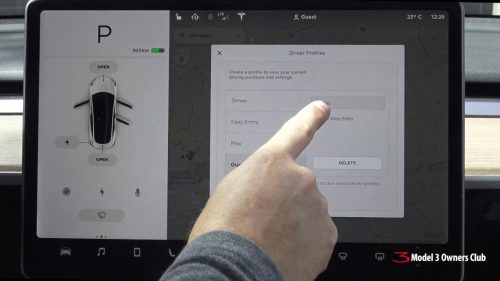
Happy Tesla Tuesday!
One of the features we really enjoy on our Escape are the driver memory buttons. We both drive the car fairly often and we are very different sizes. Hitting the memory button automatically adjusts the side mirrors and the seat. Since we use it so often, I’m very excited for driver profiles in a Tesla. When you get in, you select your profile and it will not only store the mirror and seat position but also the steering wheel position and countless other things like mirror auto fold, cruise follow distance, acceleration mode, steering mode (comfort/normal/sport), stopping mode (creep/roll/hold), seat heat, walk away door locks, navigation settings, temperature, air vent direction, and much more. Now these settings are also getting synced up to the cloud so even if you rent a Tesla, you can apply all your profile settings!
If you’ve been reading this site for a while, you know that one of my criteria whenever I buy a new gadget is whether or not it has an API that I can connect to. I want to have access to all my data! Today I have apps running that collect weights from our digital scale, temperatures and runtime from our thermostat, runtimes from our irrigation controller, the list of beers I’ve tried, how much water our house uses by the minute, how much power we use by the day, and a few other things. I used to log every trip we took in our cars too before the service that I was using died. So when I looked into an API for Tesla, I got excited.
Tesla doesn’t officially offer an API but there’s obviously one available since you connect to the car with your phone. There are a few popular services which let you use that API to get nearly endless amounts of data from your car. I’ll probably end up using TeslaMate but TeslaFi is an option if you don’t want to host it yourself. These services pull down all the data from the API and store it for you to generate even more charts than what the Tesla gives you by default. This YouTube video demos the capabilities early in the video and then goes into information about setting it up. He demos it in the browser inside the car but you could view the info from anywhere. Imagine having a log of everywhere you drove, how much energy you used on each trip, and details like how long the seat heaters were used on each trip.
Pretty much everything in a Tesla is connected into the computer. Even opening the glove box requires a button press on the screen. At first that might seem unnecessary, but when you go that route, it opens up a ton of new capabilities. For example, now you can set up a pin code that must be entered to open your glove box. Or instead of just having a button to retract your mirrors, because it’s hooked into that central computer, you can tell the Tesla to automatically fold your mirrors in or out as you approach or leave your home. The same is true for your garage door opener (if you add the Homelink accessory.) There’s a pedestrian warning speaker on the outside of the car, but you can play Spotify music through it while you’re washing the car. And since all of this stuff is controlled by a computer, you can do a lot of these things from the app on your phone too.
The phone isn’t just for running the app though. It can also serve as the key to get into your car. It connects to your car via Bluetooth as you walk up, unlocks the car, and lets you start driving. Just put your foot on the brake to “start” the car and you’re off! It takes “keyless entry” to a new level. There isn’t even a key! (There’s also a card you can keep in your wallet as a backup or you can even purchase a fob if you really want one.)
So yes, some of the scenarios are silly, but I love the open world of possibilities. Instead of trying to predict every button or feature that needs to be added, everything gets plugged into the central computer. If users want some new integration between components, it can be added in software and blasted out to everyone’s car automatically.
